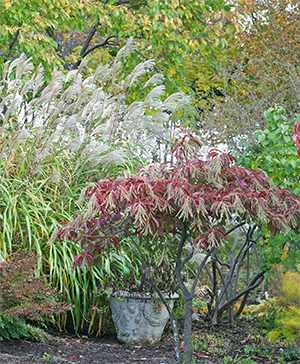
Fall is Coming to Viette's
Plan a visit our nursery in the beautiful Shenandoah Valley and wander through acres of lovely display gardens!
Our gardens are ALWAYS OPEN for you to enjoy!
There are still a few late blooming daylilies blooming in the gardens and the ornamental grasses are spectacular! Japanese anemones and crape myrtles are in full bloom and the crabapples will be coloring up soon. You won't want to miss the show!
Our Labor Day SALE has been extended!
All potted perennials, including Andre's
hybrid daylilies are
30% OFF
through September
at Viette's!
|
| Plant of the Month |
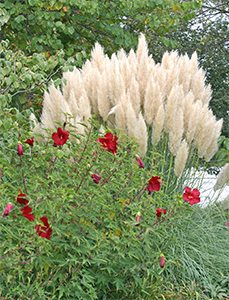 | | Hardy pampas grass (Cortaderia 'Pumila') makes a stunning backdrop for Hibiscus 'Lord Baltimore'. |
The Splendor of Ornamental Grasses
When it comes to perennial gardening, fall is often a forgotten season. Autumn is one of the most beautiful times of the year with brilliant colors and cool, crisp air. It should not spell the end of the season for your perennial garden. There are many wonderful perennials that are in their prime in the fall of the year. Ornamental grasses are one such group of plants.
Watch Mark's video tips on ornamental grasses.
 | |
The variegated foliage of Miscanthus 'Cosmopolitan' is beautiful against the brilliant fall color of a sourwood tree.
|
Diversity
Ornamental grasses are a very diverse group. They can be wide leaved or narrow leaved, bright green, yellow, blue, red, orange or even tan and brown. They can be variegated vertically as in Miscanthus sinensis 'Cosmopolitan' or even horizontally like M. sinensis 'Strictus' (porcupine grass) which adds a really interesting effect to your garden. The attractive Korean Feather Reed Grass (Achnatherum brachytricha) has a beautiful upright, arching form (30" tall) with feathery pink-purple flower heads which grow to four feet. There is even a dwarf Miscanthus named 'Adagio' with narrow silvery gray foliage and graceful plumes which reach to only four feet - perfect for smaller spaces! The beautiful, low-growing grass, Hakonechloa macra 'Aureola', will thrive in shade and has gorgeous yellow and green variegated foliage on arching stems that cascade gracefully downward creating the effect of a golden waterfall!
 | | Hakonechloa combines well with hosta in this large container. |
Summer Beauty
Ornamental grasses provide gentle motion and soothing whispers to the garden throughout the season. In mid to late summer, most grasses begin to flower. The graceful plumes of Miscanthus reach skyward and wave gently in the slightest breeze. The caterpillar-like blooms of Pennisetum increase the vertical effect that these grasses provide in the landscape. And all the while - the gentle whispering of the foliage!
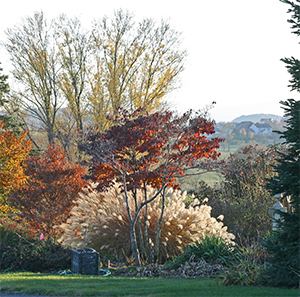 | |
Ornamental grasses stand out against brilliant fall foliage.
|
Autumn Splendor
Throughout the summer season and into the fall, ornamental grasses undergo a gradual transformation of flowers and foliage. In the cool autumn temperatures, the foliage begins to mature. Some have brilliant fall colors - reds and yellows, others mature to a beautiful tan or golden brown. The gentle motion caused by the fall breezes creates a peaceful rustling sound in the drying foliage. These are truly perennials with four season interest!
Winter Interest
As the ornamental grasses grow to their full height and beauty each summer, we tend to forget how they can add garden interest as the fall turns into winter. Not only do a lot of them turn lovely fall colors, but as they go dormant and turn brown, they become sheltered havens and even playgrounds for the birds that stay over winter. The seeds even serve as a natural source of food.
 | |
Miscanthus plumes glisten
with snow
|
True winter beauty is seeing a stand of graceful Miscanthus draped in a winter coat of snow, or seeing the sun sparkle off their thin sheets of ice after a winter drizzle. Even the shorter Pennisetum with their caterpillar-like blooms are fabulous after a light winter snow.
 | |
A beautiful fall arrangement with flowers and foliage cut from the Viette gardens
|
Decorating with Grasses
Grasses make wonderful dried arrangements for indoor or outdoor decorating. The cut plumes add color and texture to indoor arrangements. For a nice autumn display, bundle plumes and foliage together with some cut flowers of Sedum 'Autumn Joy' and Solidago spp. (Goldenrod), and for added interest and texture add some dried seed pods of Siberian Iris, Hibiscus, Oriental Poppy, or any other neat looking stuff! Just rummage through your garden - there are lots of cool looking dried flowers and foliage in the garden in the autumn that would make wonderful additions to an outdoor fall display!
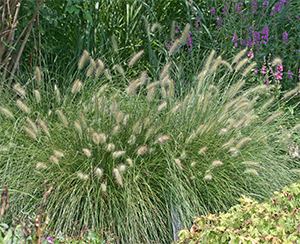 | |
Pennisetum 'Hameln' is a shorter grass growing to about 20" tall.
|
EASY to Grow and PEST-FREE!
Ornamental grasses are extremely low maintenance and trouble-free. They are drought resistant and are rarely bothered by insects or diseases. Best of all, they are DEER resistant!
Most varieties prefer full sun or bright shade, but there are some that even do well in shade. Basically, all they require is to be cut back to the ground each spring before the new year's growth begins. Spring is also the best time to divide ornamental grasses. Do not divide them in the fall.
Browse through Andre's gardens and see for yourself the splendor of ornamental grasses!
|
|
Viette Discussion Board
|
Having trouble getting through on the radio?
Visit our Discussion Board for answers to your gardening questions. Use the convenient search key to see if we have already addressed your problem! Don't see the answer? Post your question! It's EASY, just register as a member. Be sure to provide your city and state so we can better answer your question.
|
|
|
| Tip of the Month | |
A Few Tips for September
Now that the hot summer days are almost over, it's time to enjoy the garden again.
 | |
Helianthus salicifolius produces masses of vibrant yellow blooms.
|
Extend Your Gardening Season
Go out and take a look at your garden - are the blooms fading away? Is the cheerful color of summer disappearing? Maybe your garden needs a face lift!
Now's the time to add some fall dazzle!
September is one of the best times to plant trees, shrubs, and of course, perennials!
Fall Blooms
For your sunny area, the golden petals and deep brown centers of Helianthus and the Rudbeckia varieties give you rich, earthy color through the month of October.
 | |
Colorful Echinacea varieties
|
Add some of the Echinacea cultivars for large, vibrant splashes of purple-red, orange, yellow, and white. Then there are the many varieties of our old favorites, the Asters, in their vivid purples, pinks, and blues; the Sedums, with their large, handsome blooms and interesting succulent foliage; the beautiful blue-gray, aromatic foliage of Perovskia with its graceful spikes of silvery-blue flowers; and the beautiful cobalt blue blooms and contrasting red fall foliage of Ceratostigma (Plumbago). Add a Garden Showpiece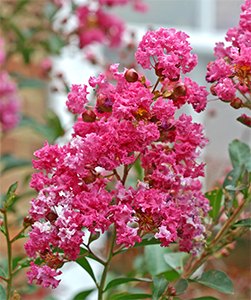 | | Crape myrtles come in all sizes and bloom colors. |
If you need a large "centerpiece" for your fall garden, consider the spectacular hardy Hibiscuswith its huge, colorful flowers or the long-blooming butterfly bush, Buddleia davidii, with beautiful flowers in many shades of purple, pink, and white that will continue to attract flocks of beautiful butterflies until frost. An excellent specimen tree or shrub for the fall garden is crape myrtle, Lagerstroemia indica. This exceptional deciduous ornamental has a long blooming season of showy flowers, a stunning fall season of blooms and colorful foliage, and a winter season of dramatic architectural beauty highlighted by distinctive cinnamon-colored exfoliating bark. What more could you ask for? 
Fall Color for the Shade
For the shade garden, you must try Anemone japonica and hardy begonia, Begonia grandis! What wonderful late blooming perennials to compliment your Hosta, Astilbe, and other shade loving favorites.
Color From Foliage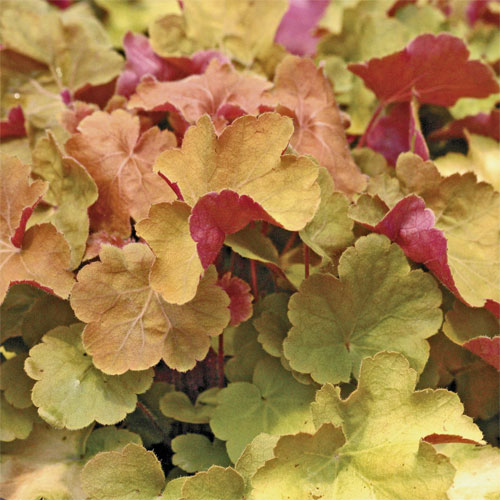 | |
Heuchera 'Caramel' adds unique color from foliage to the garden.
|
Don't forget the perennials which have such colorful foliage that they know no one season. Enhance the border garden with the beautiful red foliage of some of the new Heuchera varieties or the striking peach colored foliage of Heuchera 'Caramel'. The silvery Artemisia adds a softness to the stronger colors of Asters, Echinacea, and other perennials. The beautiful dwarf shrub, Spiraea 'Gold Flame', turns from fiery gold in spring to a dazzling red, copper, and orange in the fall. Sourwood, Oxydendrum arboreum, turns a brilliant scarlet in the fall. It is a lovely understory tree to add to your landscape. So many others ... Visit the gardens at Viette's or a public garden or arboretum near you to get more great ideas!
Dividing and Transplanting ...
 Not only is September is a great time for planting, it is also a great time to divide many perennials Not only is September is a great time for planting, it is also a great time to divide many perennials because the warm soil, increased likelihood of rain, and fewer insect and disease related problems combine to make perfect growing conditions for your new divisions. New roots will grow all winter and, come spring, will be strong enough to support lush new top growth. These divisions, supplemented with new perennials, can be used to create a new bed or to extend an existing garden.
When transplanting and/or dividing perennials that are already planted in the garden, you will want to cut the foliage back so the plant's energy can be directed to the roots instead of to the foliage and flowers. It will also reduce water loss through the leaves. Always water deeply every 7-10 days after transplanting until the new plants have become established. Apply a 2"-3" cover of mulch after planting (except for peonies and tall bearded iris). In general, fall blooming perennials like Chrysanthemums, Japanese anemones, ornamental grasses, and asters should be divided in the early spring before they begin growth.
on Saturday, October 5th at 1:30PM!
Read more about dividing perennials.
|
|
September Lecture Series at Viette's!
| |
Saturday, September 14th at 1:30 pm
Discouraging Animal Pests:
Deer, Voles, Rabbits ...
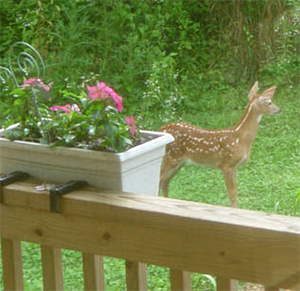 Having trouble with furry critters nibbling at your perennials, trees, shrubs, and evergreens? Tried everything to discourage them? Andre will share his years of experience as a gardener and nurseryman in discouraging these unwanted visitors - deer, rabbits, squirrels, groundhogs, skunks, voles, and moles. He will discuss repellents as well as resistant plants. With the increase in the incidence of Lyme disease carried by the deer tick, it may be more important that ever to discourage deer from visiting your gardens! Free lecture Having trouble with furry critters nibbling at your perennials, trees, shrubs, and evergreens? Tried everything to discourage them? Andre will share his years of experience as a gardener and nurseryman in discouraging these unwanted visitors - deer, rabbits, squirrels, groundhogs, skunks, voles, and moles. He will discuss repellents as well as resistant plants. With the increase in the incidence of Lyme disease carried by the deer tick, it may be more important that ever to discourage deer from visiting your gardens! Free lecture
Saturday, September 21st at 1:30 pm
The Garden in Fall
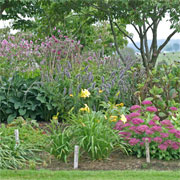 If you think that just because it's September, the "flower show" is over, think again! You won't believe how many plants are still looking great and how much color there still is in the garden. Plan for fall color through foliage, flowers, and berries. Use ornamental grasses and hardy mums to give a real feeling of fall. Andre will introduce you to some other wonderful fall blooming perennials and add a little color to your life this fall! Free lecture If you think that just because it's September, the "flower show" is over, think again! You won't believe how many plants are still looking great and how much color there still is in the garden. Plan for fall color through foliage, flowers, and berries. Use ornamental grasses and hardy mums to give a real feeling of fall. Andre will introduce you to some other wonderful fall blooming perennials and add a little color to your life this fall! Free lecture
Saturday, September 28th at 1:30 pm
All About Daffodils and Companion
Planting with Bulbs
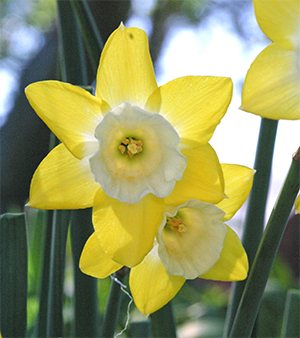 We are happy to welcome Ross Hotchkiss back to the farm for this fun and informative seminar! Ross is a "life long gardener", along with his wife Betty, who specialize in daffodils, daylilies, boxwood and almost anything that blooms! He is a Director of the Virginia Daffodil Society and has served two terms as its President. He was previously a director of the American Daffodil Society and the American Boxwood Society. We are happy to welcome Ross Hotchkiss back to the farm for this fun and informative seminar! Ross is a "life long gardener", along with his wife Betty, who specialize in daffodils, daylilies, boxwood and almost anything that blooms! He is a Director of the Virginia Daffodil Society and has served two terms as its President. He was previously a director of the American Daffodil Society and the American Boxwood Society.
Ross will cover many topics relating to bulbs including how to choose the best bulbs, how to plant for optimal success (a $10 hole for a $3 plant), and how to lift and divide bulbs correctly. He will also provide tips on how to plant many bulbs quickly and effectively. Ross will be joined by Master Gardener Stuart Williams who has planted over 1,300 varieties of daylilies (including many Viette hybrids), iris, and daffodils in his Crystal Hill Gardens which are open to the public. Stuart will discuss companion planting with bulbs. Free lecture
|
Did You Know?
|
Control Winter Lawn Weeds NOW!
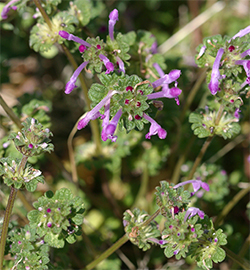 | | Henbit is a common winter annual that invades our lawns. |
Are weeds taking over your lawn? For cool-season turfgrasses, September is a perfect time to apply pre-emergent herbicides to control annual bluegrass ( Poa annua) and other winter annual weeds such as henbit, chickweed, and geranium. Keep in mind that pre-emergent herbicides will also prevent the germination of grass seed, so do not apply near newly seeded patches of turf. Since many broadleaf weeds, such as dandelion, various clovers, and plantain, show a new burst of growth in the fall, now is a great time to zap them with a post-emergent broadleaf herbicide. In the fall, perennials (including perennial weeds) begin to prepare for winter by moving nutrients and stored starches from their leaves into their roots. Spraying systemic herbicides at this time means that these chemicals also get transported down to the roots more effectively! Since the grass is still actively growing, it will quickly fill in the bare spots. Andre recommends the following for broadleaf lawn weed control. They contain both a pre-emergent and post-emergent control for many common lawn weeds:
- Bonide Weed Beater Complete or Weed Beater Complete with Fertilizer
- Bayer Advanced Season Long Weed Control for Lawns or Southern Season Long Weed Control
Read the label before applying any pesticide!
Holly Berries ... or not!
Why don't I have berries on my hollies?
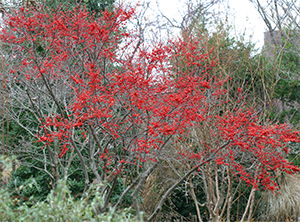 | |
Deciduous holly 'Sparkleberry' brightens the winter garden.
|
Hollies are dioecious plants, meaning the male and female flowers are on separate plants. If you only have a female holly and no male in the area, you will never get berries because there is no pollen to pollinate the female flowers. Conversely, if you have only a male holly, you also won't get berries. This is true of both the evergreen hollies and the deciduous hollies.
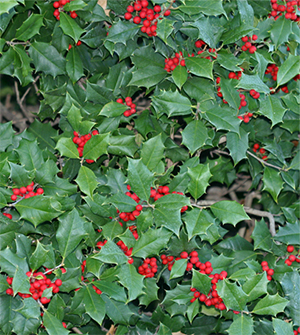 | |
American Holly
|
If you have NEVER had berries on your hollies, this is probably the reason.
Male hollies usually have male-type names like 'Southern Gentlemen', 'Jim Dandy', 'China Boy', etc. Check to be sure that you have both a male and female plant. One male can pollinate multiple female plants. Be sure that the male plant you get is compatible/will pollinate the female holly you plant.
If you have had berries in the past and not this year, it could be an environmental or weather related issue that could have affected pollination of the flowers in the spring. We have found that misty, rainy, or cold weather in the spring at the time of flowering can inhibit or limit pollination. This would cause few or no berries on your holly bushes or trees.
You should also feed your hollies in the spring and fall with Holly-tone.
|
If you enjoy our newsletter, please pass it along to your gardening friends!
|
On the Viette's Views Gardening Blog
| |
|
| Gardening Questions? |
 Listen to Andre on the radio every Saturday morning from 8:00-11:00 on "In the Garden with Andre Viette"
|
|
Aloha - Join Mark on a Trip to Hawaii
|
Hawaii Four-Island Agricultural Tour
Departing Friday, January 17th, 2014
 Join Mark Viette on this unique tour of Oahu, Kauai, Maui, Hawaii
Tour highlights include:
Oahu - Honolulu, Waikiki Beach, Punchbowl Crater, Iolani Palace, Pearl Harbor, USS Arizona Memorial with shuttle boat ride
Kauai - Opaekaa Falls, Wailua Riverboat Cruise, Fern Grotto, Steel Grass Farm
 Maui Maui - Iao Valley State Park and Iao Needle Lookout Point, Old Whaling Capital of Lahaina, Maui Gold Pineapple Plantation
Hawaii - Hilo, Volcanoes National Park, Mauna Loa & Kilauea Volcanoes, Jaggar Museum, Giant Ferns, Thurston's Lava Tube, Banyan Tree Drive, Mountain Thunder Coffee Plantation, NELHA, Abalone Farm
|
When You're in the Area
| |
Visit our friends at Packsaddle Ridge Golf Club and enjoy a breathtaking round of golf after a visit to the beautiful gardens at Viette's.
Packsaddle Ridge Golf Club received a 5 Star Rating "Best Places To Play" by Golf Digest, 2008/2009. This public 18-hole championship golf course is nestled in the beautiful Shenandoah Valley and features a challenging course with incredible views of the Appalachian Mountains and the valley below.
3067 Packsaddle Trail ~ Keezletown, VA 22832
Phone: 540-269-8188
|
|
|